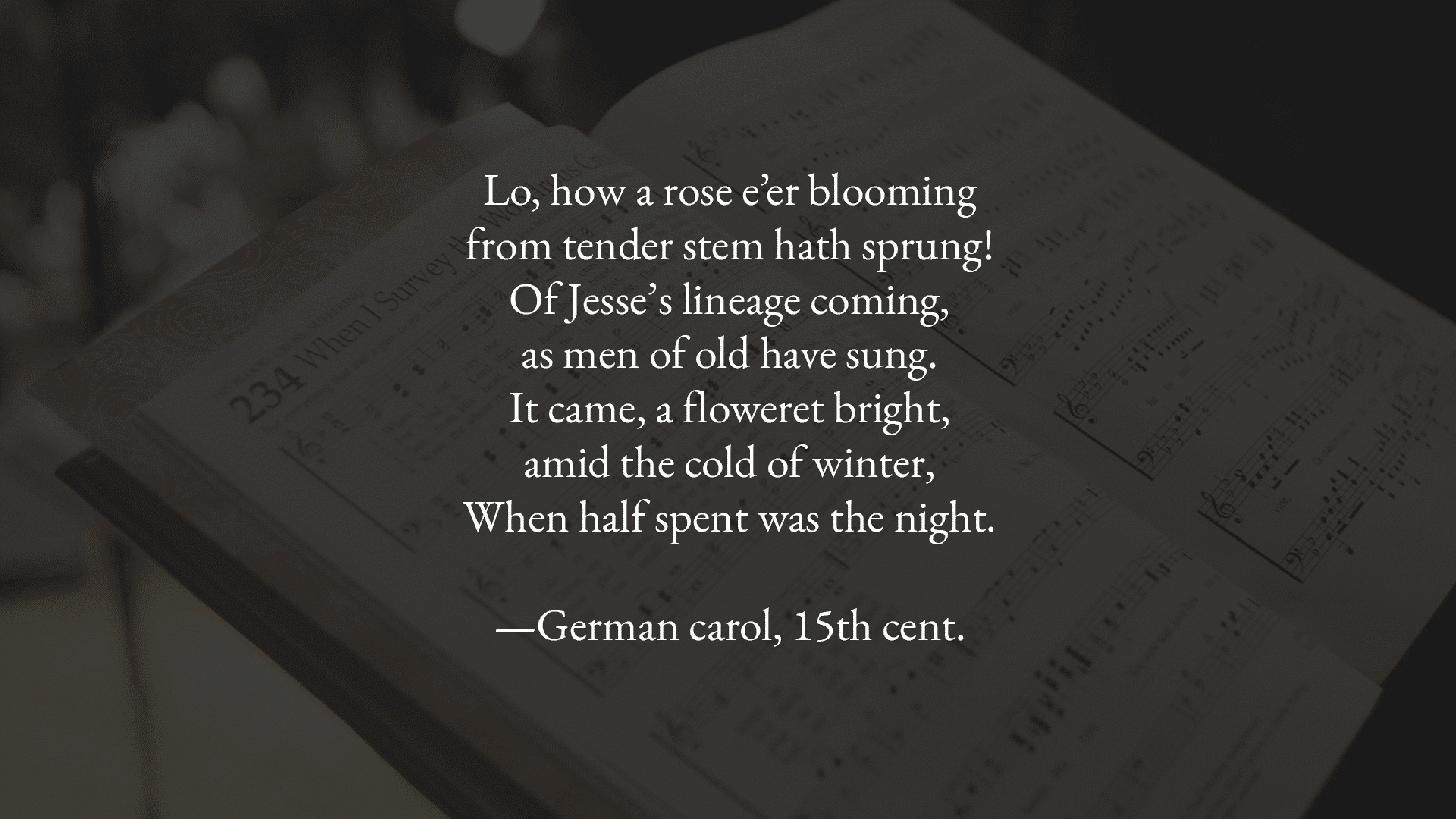“Lo, How a Rose E’er Blooming” is likely somewhat familiar to modern ears. As the most popular translation (one of many) of the German “Es Ist Ein Ros Entsprungen,” this is an a capella Christmas choral favorite, set to ES IS EIN’ ROS’ as harmonized by Michael Praetorius in 1609. Here is the text, including the third verse which is not usually included in hymnals or choral arrangements:
Lo, how a rose e’er blooming from tender stem hath sprung!
Of Jesse’s lineage coming, as men of old have sung.
It came, a floweret bright, amid the cold of winter,
When half spent was the night.Isaiah ’twas foretold it, the rose I have in mind;
With Mary we behold it, the virgin mother kind.
To show God’s love aright, she bore to men a Savior,
When half spent was the night.The shepherds heard the story proclaimed by angels bright,
How Christ, the Lord of glory was born on earth this night.
To Bethlehem they sped and in the manger found Him,
As angel heralds said.This flower, whose fragrance tender with sweetness fills the air,
Dispels with glorious splendor the darkness everywhere;
True Man, yet very God, from sin and death He saves us,
And lightens every load.O Savior, child of Mary, who felt our human woe,
O Savior, King of glory, who dost our weakness know;
Bring us at length we pray, to the bright courts of Heaven,
And to the endless day!
Interestingly, the German original, first published in a Roman Catholic hymnal1Geistliche Kirchengesang, published at the turn of the 16th century. compares Mary to the “rose,” not Jesus: “Das Röslein, das ich meine, davon Jesaia sagt: ist Maria die Reine” // “The rose that I mean, of which Isaiah speaks, is Mary the pure.” Protestants have adjusted the text to focus on Christ: “Isaiah ’twas foretold it, the rose I have in mind; With Mary we behold it . . .” To this day, Catholics and Protestants sing the song somewhat differently.
The question which we must ask, however, is “Where does Isaiah foretell ‘this rose I have mind’”? The only KJV reference in Isaiah to a “rose” is Isa. 35:1, which doesn’t fit the hymn. The answer is found by examining the first verse: “Lo, how a rose e’er blooming, From tender stem hath sprung. Of Jesse’s lineage coming, As men of old have sung.” Note the chronological connection—the backward look—between “men of old” in v. 1 and “foretold” in v. 2. Referencing the ideas of v. 1 with Isaiah, we naturally will go to Isaiah 11:1: “And there shall come forth a rod out of the stem of Jesse, and a Branch shall grow out of his roots” (KJV), which is clearly a messianic prophesy.
Then whence the “rose”?
After researching the matter, I suggest that several factors intersected to bring about this use of “rose” in the hymn as we have it today. (1) In medieval iconography, the rose was symbolic for Mary.2This is the origin of the English word rosary, as well as the English name “Rosemary.” See Anne Winston-Allen, Stories of the Rose: The Making of the Rosary in the Middle Ages (Pennsylvania … Continue reading (2) In addition, the Latin Vulgate of Isaiah 11:1 reads “ascendet” — “And there shall come forth a rod out of the root of Jesse, and a flower shall rise up out of his root.” (3) Ergo, we have “Isaiah foretelling” that a flower will come forth from Jesse, which in the original German hymn was understood as Mary, to whom was born Christ, the “floweret” (Blümlein). (4) Protestants no doubt objected to Mary as the subject of Isaiah 11:1, and shifted the hymn text to make Jesus the subject.3And while the rose was most commonly associated with Mary in medieval iconography, it was also associated with Christ, especially his passion.
Enjoy this hymn as sung chorally or listen to the tune alone on the organ.
References
| 1 | Geistliche Kirchengesang, published at the turn of the 16th century. |
|---|---|
| 2 | This is the origin of the English word rosary, as well as the English name “Rosemary.” See Anne Winston-Allen, Stories of the Rose: The Making of the Rosary in the Middle Ages (Pennsylvania State University, 1997), 88-89. |
| 3 | And while the rose was most commonly associated with Mary in medieval iconography, it was also associated with Christ, especially his passion. |




